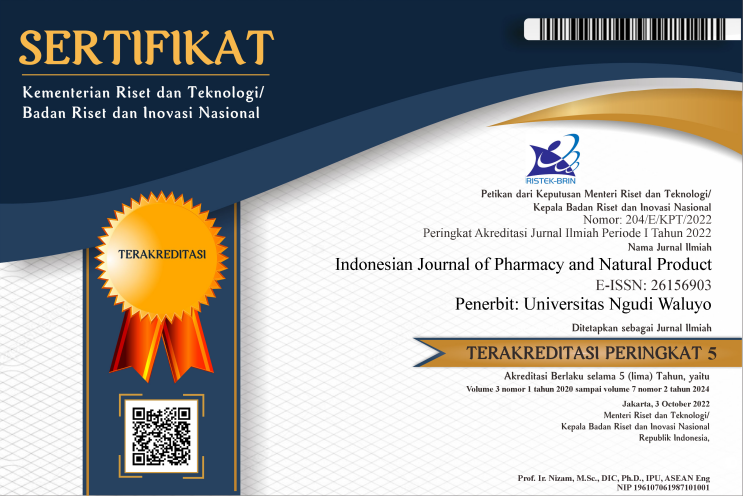Pengaruh Pemberian Informasi Obat Dengan Media Video Terhadap Kepatuhan Minum Obat Pasien Hipertensi Di Ungaran
DOI:
https://doi.org/10.35473/ijpnp.v2i2.268Abstract
Hipertensi merupakan salah satu penyakit kronis yang menjadi satu prioritas masalah  kesehatan  di  Indonesia  maupun  di  dunia. penyakit hipertensi dapat menyebabkan komplikasi seperti dapat menyebabkan oklusi arteri, cedera iskemik dan stroke sebagai komplikasi  jangka  panjang. Maka diperlukannya pemahaman oleh pasien tentang instruksi pengobatan dan peningkatan kepatuhan pasien melalui pemberian informasi obat dengan media video. Penelitian dilakukan secara prospektif dengan pretest-posttest design dan menggunakan rancangan cross sectional. Pengambilan sampel dilakukan secara purposive sampling dan didapatkan sampel sebanyak 40 orang. Data dianalisis menggunakan uji t-berpasangan. Hasil penelitian di Puskesmas Lerep menunjukkan kepatuhan sebelum intervensi kategori sedang 60%, kategori rendah 35% dan kategori tinggi 5%. Kepatuhan sesudah intervensi kategori sedang 20%, kategori rendah 0% dan kategori tinggi 80%. Nilai signifikansi uji t berpasangan yaitu 0,000 (<0,05). Hasil penelitian di Klinik Gracia kepatuhan pasien sebelum intervensi adalah rendah (20%), sedang (55%), dan tinggi (25%), setelah intervensi terjadi peningkatan kepatuhan yaitu rendah (5%), sedang (5%) dan tinggi (90%). Nilai signifikasi uji t-berpasangan dalam penelitian ini yaitu 0,000 < 0,05. Tingkat kepatuhan untuk uji pill count terdiri atas dua kategori yaitu patuh (kepatuhan≥80%) dan tidak patuh (kepatuhan<80%). Seluruh responden, baik pada Puskesmas Lerep maupun Klinik Gracia menunjukkan skor kepatuhan ≥80%, termasuk kategori patuh. Hasil penelitian menunjukan bahwa penyuluhan dengan media video dapat meningkatkan kepatuhan minum obat hipertensi di puskesmas Lerep dan Klinik Gracia.
Kata Kunci : Hipertensi, Media Video, Kepatuhan Minum Obat, MMAS
Hypertension is a chronic disease which is a priority health problem in Indonesia and in the world. Hypertension can cause complications such as can cause arterial occlusion, ischemic injury and stroke as long-term complications. Then there is a need to increase patient compliance by using video to provide drug information in order to increase patient’s understanding. The study was conducted prospectively with pretest-posttest design using cross sectional design. Forty sample was chosen by purposive sampling method. Data were analyzed using paired t-test. The results at Lerep Health Centre showed that the patient’s compliance before the intervention was categorized as moderate (60%), the low (35%) and high (5%). After the intervention, the moderate group was down to 20%, low was down to 0%, and the high group was increased to 80%. The significance value of paired t-test is 0,000 (<0.05). Research results at Gracia Clinic showed that patient’s compliance before intervention was low (20%), moderate (55%), and high (25%), and after intervention there was an increase in patient’s compliance that was low (5%), moderate (5%) and high (90 %). The significance value of paired t-test in this study is 0,000 <0.05. The level of adherence to the pill count test consists of two categories: adherence (80% adherence) and non-adherence (adherence <80%). All respondents, both at the Lerep Health Center and the Gracia Clinic showed a compliance score of ≥80%, including the compliance category. Counseling using video could improve compliance with taking hypertension medication at the Lerep health center and Gracia Clinic.
Keywords: Hypertension, Video, Medication Compliance, MMAS
References
Anggraini A.D. 2009. Faktor-Faktor yang Berhubungan dengan Kejadian Hipertensi Pada Pasien yang berobat di Poliklinik Dewasa Puskesmas Bangkinang Periode Januari 2009. Skripsi. Universitas Riau. Riau.
Azhari, M. H. (2017). Faktor-Faktor yang Berhubungan dengan Kejadian Hipertensi di Puskesmas Makrayu Kecamatan Ilir Barat II Palembang. Jurnal Aisyah : Jurnal Ilmu Kesehatan, 2(1), 23. https://doi.org/10.30604/jika.v2i1.29
CiCiriello S, Johnston RV, Osborne RH, Wicks I, deKroo T, Clerehan R, O’Neill C, Buchbinder R, 2013, Multimedia educational interventions for consumers about prescribed and over-the-countermedications (Review), Cochrane Database of Systematic Reviews.
Erdine Serap, 2009, Compliance With the Treatment of Hypertension: The Potential of Combination Therapy, The Journal Of Clinical Hypertension. 12:40–46. doi: 10.1111/j.1751-7176.2009.00200.x
Depkes RI. 2015. Profil Kesehatan Indonesia Tahun 2015. Jakarta: Kementrian Kesehatan RI
Dinkes Jateng. 2015. Profil Kesehatan Provinsi Jawa Tengah. Semarang: Dinas Kesehatan Jawa Tengah.
Han, H. R., Chan, K., Song, H., Nguyen, T., Lee, J. E., & Kim, M. T.2011. Development And Evaluation Of A Hypertension Knowledge Test For Korean Hypertensive Patients. Journal of Clinical Hypertension, 13(10), 750–757. https://doi.org/10.1111/j.1751-7176.2011.00497.
Santrock, J. W. (2002). Life-span Development Perkembangan Masa Hidup Edisi Kel Gans, K. M., Risica, P. M., Dulin-Keita, A., Mello, J., Dawood, M., Strolla, L. O., & Harel, O.2015. Innovative Video Tailoring For Dietary Change: Final Results Of The Good For You Cluster Randomized Trial. International Journal of Behavioral Nutrition and Physical Activity, 12(1). https://doi.org/10.1186/s12966-015-0282-5ima. Penerbit Erlangga. Jakarta.
Wahyuni, E. D. 2011. Hubungan Tingkat Pendidikan dan Jenis Kelamin Dengan Kejadian Hipertensi Di Kelurahan Jagalan di Wilayah Kerja Puskesmas Pucangsawit Surakarta. Jiki, 1(1), 112–121. Universitas Sahid Surakarta.
Widharto.2007. Bahaya Hipertensi. Jakarta Selatan. Sunda Kelapa Pustaka.
WHO. 2011. Non Communicable Disease in Indonesia: A Profile New Delhi: WHO Regional Office For Southeast Asia.



